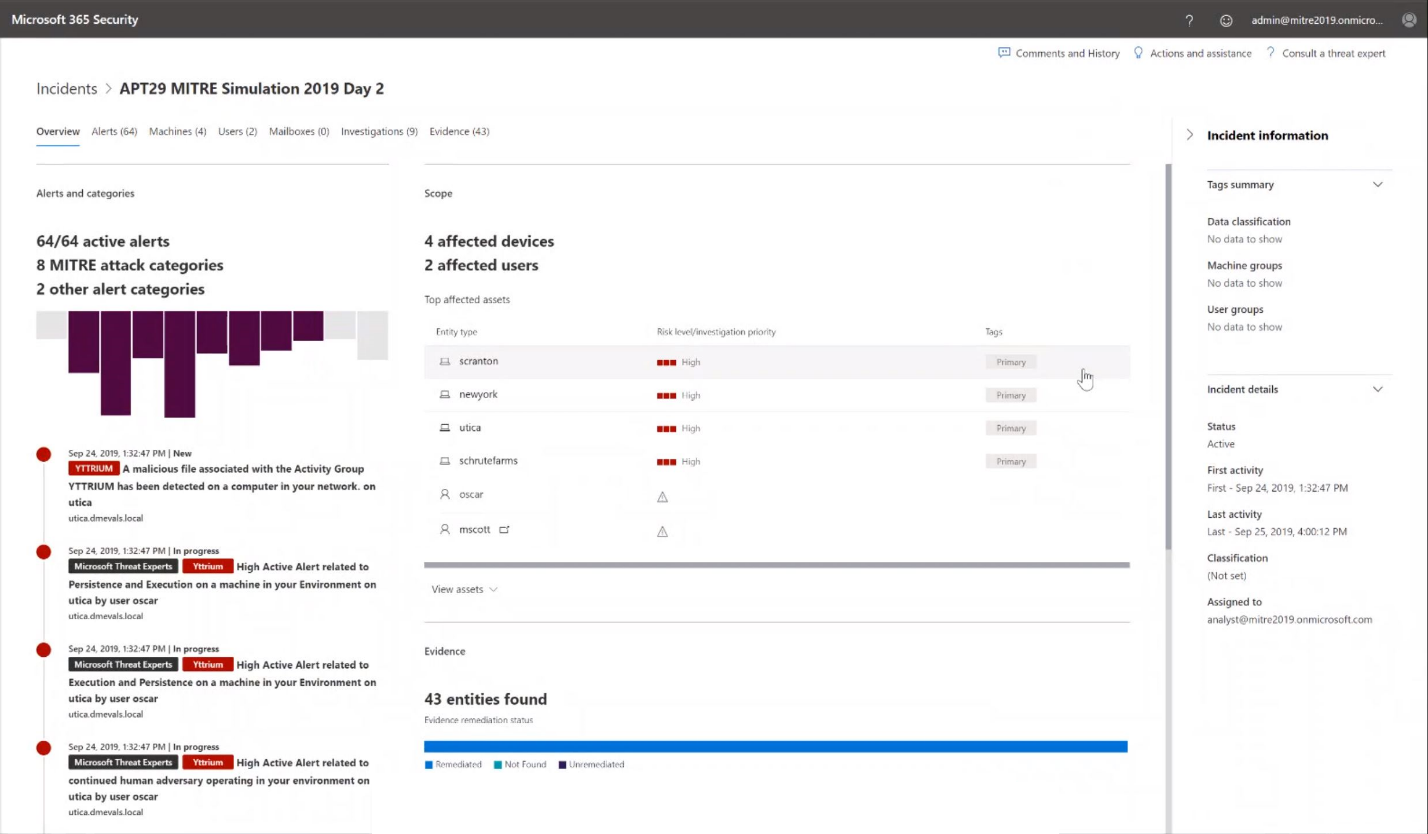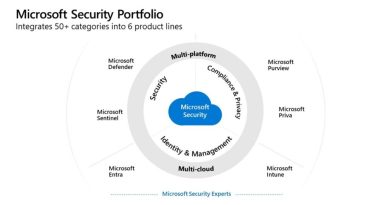MITRE ATT&CK APT 29 evaluation proves Microsoft Threat Protection provides deeper end to end view of advanced threats
As attackers use more advanced techniques, it’s even more important that defenders have visibility not just into each of the domains in their environment, but also across them to piece together coordinated, targeted, and advanced attacks. This level of visibility will allow us to get ahead of attackers and close the gaps through which they enter. To illustrate that imperative, the 2019 MITRE ATT&CK evaluation centered on an advanced nation-state threat actor known to the industry as Advanced Persistent Threat (APT) 29 (also known as Cozy Bear) which largely overlaps with the activity group that Microsoft calls YTTRIUM. . The test involved a simulation of 58 attacker techniques in 10 kill chain categories.
Microsoft participated in the second MITRE ATT&CK endpoint detection product evaluation published today. The evaluation is designed to test security products based on the ATT&CK (Adversarial Tactics, Techniques & Common Knowledge) framework, which is highly regarded in the security industry as one of the most comprehensive catalog of attacker techniques and tactics. Threat hunters use this framework to look for specific techniques that attackers often use to penetrate defenses. Testing that incorporates a comprehensive view of an environment’s ability to monitor and detect malicious activity with the existing tools that defenders have deployed across an organization is critical.
Although this test was focused on endpoint detection and response, MITRE ran the simulated APT29 attack from end to end and across multiple attack domains, meaning defenders benefited from visibility beyond just endpoint protection. This gave Microsoft the unique opportunity to bring Microsoft Threat Protection (MTP) to the test.
Microsoft Threat Protection expands Microsoft Defender ATP from endpoint detection and response (EDR) to an extended detection and response (XDR) solution, and is designed to provide extended detection and response by combining protection for endpoints (Microsoft Defender ATP), email and productivity tools (Office 365 ATP), identity (Azure ATP), and cloud applications (Microsoft Cloud App Security/MCAS). As customers face attacks across endpoints, cloud, applications and identities, MTP looks across these domains to understand the entire chain of events, identifies affected assets, like users, endpoints, mailboxes, and applications, and auto-heals them back to a safe state.
Microsoft Threat Protection delivers coverage across the entire kill chain, not just the endpoint
To fully execute the end to end attack simulation of APT29, MITRE required participants to turn off all proactive protection and blocking capabilities. For Microsoft Threat Protection, this meant that all the capabilities that would normally block this kind of attack such as automatic remediation flows, application isolation, attack surface reduction, network protection, exploit protection, controlled folder access, and next-gen antivirus prevention were turned off. However, Microsoft Threat Protection audit capabilities for these features enabled recording of a variety of points during the attack when MTP (had it been fully enabled) would have prevented or blocked execution, likely stopping the attack in its tracks.
During this evaluation Microsoft Threat Protection delivered on providing the deep and broad optics, near real time detection through automation, and a complete, end-to-end view of the attack story. Here is how Microsoft Threat Protection stood out:
- Depth and breadth of optics: Our uniquely integrated operating system, directory, and cloud sensors contributed deep and broad telemetry coverage. AI-driven, cloud-powered models collaborating across domains identified malicious activities and raised alerts on attacker techniques across the entire attack kill chain:
-
- Microsoft Defender ATP recorded and alerted on endpoint activities including advanced file-less techniques, privilege escalation, and credential theft and persistence – leveraging deep sensors like AMSI, WMI, and LDAP.
- Azure ATP watched and detected account compromise at the domain level, and lateral movement, such as pass-the-hash and the more sophisticated pass-the-ticket (Golden Ticket attack).
- Microsoft Cloud App Security identified exfiltration of data to the cloud (OneDrive).
- Detection and containment in near real time:Nation state attacks of this magnitude can take place over the course of as little as a few hours, which means that Security Operations Centers (SOCs) often have little to no time to respond. Near-real-time automated detection of advanced techniques is critical to address this challenge. Where possible, active blocking, prevention and automatic containment will make the difference between an attempted versus a successful compromise. MTP’s prevention capabilities along with fast detection and behavioral blocking are exactly designed for this purpose.
- A complete attack story: Throughout this evaluation, Microsoft Defender ATP, Azure ATP, and Microsoft Cloud App Security, combined with the expertise of Microsoft Threat Experts generated nearly 80 alerts – for SOC teams, manually following up on each one of these alerts is overwhelming. MTP consolidated the alerts into just two incidents, dramatically simplifying the volume of triage and investigation work needed. This gives the SOC the ability to prioritize and address the incident as a whole and enables streamlined triage, investigation, and automated response process against the complete attack. With MTP we have built in automation that identifies the complex links between attacker activities and builds correlations across domains that piece together the attack story with all of its related alerts, telemetry, evidence and affected assets into coherent incidents. These comprehensive incidents are then prioritized and escalated to the SOC.
Microsoft Threat Experts, our managed threat hunting service, also participated in the evaluation this year. Our security experts watched over the signals collected in real time and generated comprehensive, complementary alerts, which enriched the automated detections with additional details, insights and recommendations for the SOC.
Real world testing is critical
Attackers are using advanced, persistent, and intelligent techniques to penetrate today’s defenses. This method of testing leans heavily into real-world exploitations rather than those found solely in a lab or simulated testing environment. Having been part of the inaugural round of the MITRE ATT&CK evaluation in 2018, Microsoft enthusiastically took on the challenge again, as we believe this to be a great opportunity, alongside listening to customers and investing in research, to continuously drive our security products to excellence and protect our customers.
This year, for the first time, we were happy to answer the community call from MITRE, alongside other security vendors, to contribute unique threat intelligence and research content about APT29, as well as in evolving the evaluation based on the experience and feedback from last year, yielding a very collaborative and productive process.
Thank you to MITRE and our customers and partners for your partnership in helping us deliver more visibility and automated protection, detection, response, and prevention of threats for our customers.
READ MORE HERE




